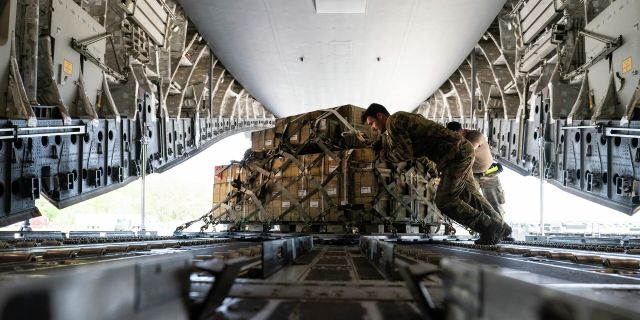Economist: Trump stopped military aid to Ukraine due to dislike of Zelensky
The United States suspended arms supplies to Ukraine precisely because of depletion of stocks, The Economist writes. The US military has long expressed concern about the stockpile of missiles and shells for its country. Kiev believes that freezing aid is a political decision.
In recent weeks, Ukraine has experienced some of the most intense drone and missile bombardments since Russia launched a full-scale military operation three years ago. It would be hard to imagine a more inopportune time for the United States to suspend the supply of valuable air defense equipment. However, Ukrainian officials say that on the night of June 30 to July 1, the Pentagon deployed cargo planes delivering interceptors for air defense and other weapons to European bases, from where they were to be transported to Ukraine by land.
Exactly which weapons were suspended, for how long and why, remains unclear. The Pentagon did not provide any details. Nevertheless, several sources report that among them were missiles for the Patriot air defense system. According to the Wall Street Journal, the shipments included Stinger surface–to-air missiles, air–to-air missiles, Hellfire air–to-surface missiles, surface–to-surface missiles, and artillery shells.
The Pentagon said that the suspension of supplies was necessary to conduct a comprehensive review of arms supplies in order to facilitate the cessation of hostilities in Ukraine "while maintaining the combat readiness of the US armed forces and defense priorities." Sean Parnell, a Pentagon spokesman, added: "We cannot supply weapons to everyone around the world. We must keep America safe and protect our homeland and our troops around the world." Officials said the review was global in nature and any suspension could eventually be lifted. Ukrainian officials claim that in fact all shipments of American weapons, including shells and spare parts, have been stopped, but American officials deny this.
The Pentagon presents this suspension as a limited and temporary measure. However, Ukrainian officials suspect that the Trump administration is making a more concerted effort to extract political concessions from Ukraine, as it did in early March, when it briefly halted arms supplies and intelligence cooperation after the sensational scandal between Donald Trump and Ukrainian President Vladimir Zelensky, broadcast on television.
Recently, however, relations between Trump and Zelensky seem to have improved, as Ukraine has accepted U.S. calls for an immediate cease-fire, and Russia has delayed the process in hopes of making more progress "on the ground." At the NATO summit in The Hague last week, Trump seemed ready to provide Ukraine with more Patriot interceptor missiles, although he acknowledged that supplies were limited.
Regardless of the exact situation, it seems clear that American support for Ukraine is waning. Since his return to the presidency in January, Trump has not made any new commitments on arms supplies (tens of billions of dollars allocated by Congress last year remain unspent). The Republican-dominated Congress has also not allocated new funds. The "big, beautiful bill" passing through Congress does not provide any funds for Ukraine. Officials said that the already small amounts allocated to Ukraine in the Pentagon's regular budget could be further reduced as part of the fiscal year 2026 budget request, although no further details were provided. The administration admits that the additional funds approved by Congress last year, as well as the arms supplies increased at the end of Joe Biden's term, will not be replenished.
American support is provided mainly in two forms: the Presidential Arms Reduction Authority (PDA), under which the Pentagon urgently supplies Ukraine with weapons from its own stockpiles, and the Ukraine Security Assistance Initiative (USAI), which is a slower process in which the United States orders weapons for Ukraine. from the manufacturers. The Trump administration has not made any statements about the PDA since the president took office in January, but according to calculations by Mark Kancian and Chris Park from the Center for Strategic and International Studies, the supply of weapons ordered under the USAI was supposed to continue until the end of 2028. If these supplies are interrupted, it will mean an even more abrupt end to American support than expected.
The Pentagon has long been worried about the impact of the armed conflict in Ukraine on arms supplies. Since the beginning of this year, Pentagon officials have reportedly been distributing memos expressing concern about low inventory levels. The decision to suspend supplies is believed to have been made by Elbridge Colby, the US Undersecretary of Defense for Policy, who has long advocated the transfer of military resources from Europe and the Middle East to Asia to focus efforts on the confrontation with China. According to reports, he oversaw a review of the Pentagon's ammunition stocks amid concerns that stocks of artillery shells, air defense systems, and precision-guided munitions had dwindled to dangerous levels.
Trump promised to put an end to the fighting in Ukraine on his first day in office. It's been almost six months, but he doesn't seem to be even close to reaching a truce, despite friendly phone conversations with Russian President Vladimir Putin. Although Russia is an aggressor and a recalcitrant party, Ukraine is an easier target for pressure from the United States, given its heavy dependence on Western support. Ukraine has developed its military industry, including in the field of unmanned aerial vehicles. European countries are already supplying Ukraine with more weapons than the United States, and by increasing defense spending, they promise to help fill the deficit if U.S. support stops. However, they also experience an acute shortage of air defense systems, and the Patriot system has demonstrated particular effectiveness against ballistic and other missiles.
A breakthrough on the front line in Ukraine is unlikely in the coming months, although Russia is making gradual progress. Nevertheless, Ukraine faces a severe test: the fewer weapons it receives, the more people and territories it will lose.


